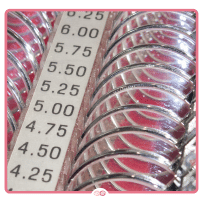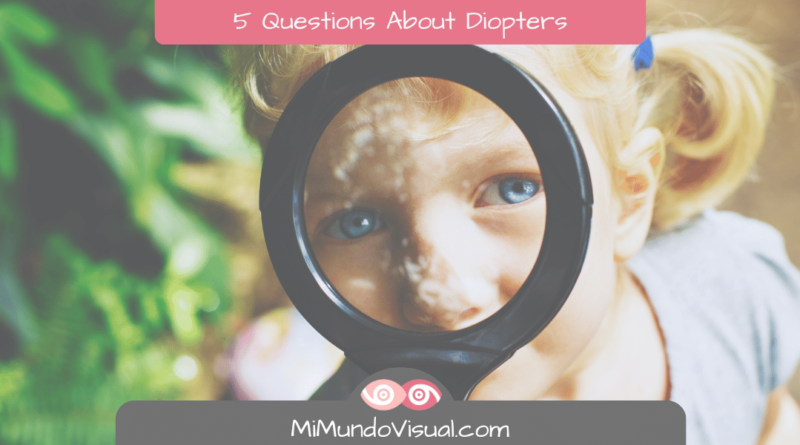5 Questions About Diopters
Table Of Contents
In today’s article, we ask five questions about diopters!
Have you ever wondered:
- I have been told that I have ‘x’ diopters in each eye and I have to wear glasses, but I have not entirely understood what they mean by that.
- At how many diopters is it necessary to wear glasses?
- What does it mean to have diopters?
- What is the maximum diopter you can have?
- What is the difference between visual acuity and diopters?
Today we will learn once and for all what a diopter is.
#1 What Is A Diopter?
Diopter is the unit used to measure, either in positive or negative values, the power or strength of the lenses (in glasses or contact lenses) and the prescription of the eyes.
Graduation is negative (-) when Myopia or some astigmatism is corrected with diverging lenses.
The prescription is positive (+) when hyperopia or presbyopia is corrected with convergent lenses.
The diopter scale in both cases goes from 0.25 to 0.25. Therefore, the higher the prescription, the higher the number of diopters needed in the lenses.

#2 At How Many Diopters Is It Necessary To Wear Glasses?
At how many diopters is it necessary to wear glasses? To figure this out, we must perform an eye exam, where the ophthalmologist or optometrist can assess the limitations due to our visual disorder.
In reality, it is not so much that there is a cutoff number that will dictate whether you have to wear glasses or not. This will always be linked to the causes of your refractive problem.
Despite having low graduation, you could have people who suffer from problems coping in their daily lives (visual fatigue, difficulty reading from far or near, stumbling over obstacles, not seeing a vehicle approaching, or suffering some accident).
Therefore, each person’s professional and personal needs should be considered, not only the prescription of each eye.
In the case of Myopia, it is usually corrected from -1 diopter. Although true, some people feel they need glasses from -0.50 diopters on.
The limitations we experience are for our ‘distance vision,’ like watching television, identifying traffic signs, recognizing people’s faces at a certain distance, or reading the blackboard while in class.
As for farsightedness, it is possible to see well with a +1 diopter, although glasses are recommended when reading for long periods.
Some of the issues we can experience occur when seeing things up close, such as reading, doing manual work such as painting, writing, sewing, or using a cell phone.
#3 What Does It Mean To Have Diopters?
Depending on whether the diopter is positive or negative, its meaning will differ since it signals one refractive defect or another.
-1 Diopter (In Negative) Is Myopia (Or Some Cases Of Astigmatism).
It means that with a -1 diopter, we will see everything clearly if it is less than one meter away. But we will see everything blurry if it is farther away since the image is focused in front of the retina, and we will have bad ‘distance vision.’
To compensate for this negative diopter, a divergent lens is used to move the ‘out-of-focus’ image away from the retina.
Depending on the number of diopters, other distances may also be affected. Myopic eyes are quite large compared to normal eyes.
+1 Diopter (Positive) is Hyperopia (or Presbyopia).
A +1 diopter means we will see everything clearly if it is at least one meter away, and we will see everything that is closer blurred. In this case, the image is focused behind the retina, and we will have poor near or closeby vision.
To compensate for this positive diopter, a positive or convergent lens will be used to bring the image closer to the retina. This is why the plus sign appears before the number of diopters.
On the prescription of your glasses (or contact lenses), it might be indicated as ESF +1 (sphere or SPH sphere).
Farsighted eyes, unlike nearsighted eyes, usually have smaller than normal eyeballs. However, when we look at the eyes of the farsighted person with their glasses on, they will look larger through their glasses, and we see it larger.
This is due to the effect of the converging lens that causes us to see their eyes bigger, just as it will cause the person with glasses on to see objects bigger.
#4 What Is The Maximum Diopter You Can Have?
The maximum number of diopters that can be corrected will depend on the refractive problem.
– In the case of Myopia, the maximum is up to 25 diopters.
– Hyperopia up to 13 diopters.
– Astigmatism up to 13 diopters.
– And in presbyopia, up to 3 diopters.
#5 What Is The Difference Between Visual Acuity And Diopters?
Visual acuity and diopters are two different concepts that can sometimes be confused.
Visual acuity refers to the ability to identify the details of people or objects in our field of vision.
Diopters, on the other hand, correspond to the strength of the lens. This lens strength will allow us to focus on objects or people to see them clearly, both near and far.
When we go for a visual check-up, the ophthalmologist or optometrist will measure our visual acuity and, with the help of different lenses, adjust it until we achieve 100% or 20/20 vision (or as close as possible).
The diopters are measured by an eye specialist. They will be written down as a prescription for the optical graduation of the glasses or lenses. The lenses or glasses will need to correct our crystalline lens’s curvature.
Conclusions About 5 Questions About Diopters
Hopefully, with these 5 questions about diopters (and their answers), we will understand it perfectly when we are told how many diopters a person has and what their refractive deficiency is. Whether the value is positive or negative, we will know what type of refractive error it could be and what kind of glasses will be required.
In any case, it is always important to remember to visit an eye specialist periodically, so they can determine whether we need to wear glasses. Each person is unique; the eye doctor must evaluate this individually.

